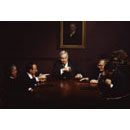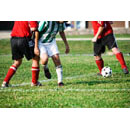Lesson 56 – الدَّرْسُ السَّادِسُ وَالْخَمْسُونَ
The sound masculine plural - جَمْعُ المُذَكَّرِ السَّالِمِ
The sound masculine plural – جَمْع المُذَكَّر السَّالِم
- We are still in lesson fifty six of our free Arabic language course. This Arabic course with images and audios will help you learn Arabic.
- We studied the Arabic broken plural in lesson 34 (جَمْعُ التَّكْسِير /ĵamξ at-taksīr). We learnt in that lesson that there are no rules to form the Arabic broken plural and we have to memorize its form for any new noun we learn, here are some examples to remind you about the broken plural:
| Picture | Broken plural | Singular | |
| English | Arabic | ||
|
| /kutubun/ | Book | /kitābun/ |
|
| /buyūtun/ | Home | /baytun/ |
|
| /manāzilun/ | House | /manzilun/ |
|
| /ŧullābun/ | Student | /ŧâlibun/ |
|
| /suħubun/ | Cloud | /saħābun/ |
|
| /quran/ | Village | /qariatun/ |
- As you notice, the broken plural has a different pattern (form) for each of the above mentioned words. The form of the singular is changed when it is turned into broken plural, so that it is called (جمع التَّكْسِير /ĵamξ at-taksīr/). It is not formed by adding suffixes or prefixes (letters in the beginning or in the end) to the singular, instead it is formed by breaking the letters of the singular form then restructuring them in a different pattern. You may notice that this broken plural is used for both masculine and feminine words, e.g.:
- we also studied another type of plural in lesson (36), which is the feminine sound plural, this plural is formed by adding /alif/ and /tā’/ (ات /āt) to the feminine singular word. The following table is to remind ourselves about that kind of plural:
|
Plural الجَمْع
| Singular المُفْرَد | |
| English | Arabic | |
| /muđđhafātun/ | Female employee | /muđđhafatun/ |
| /ξāmilātun/ | Female worker | /ξāmilatun/ |
- In this lesson we will learn the third type of plural which is the sound masculine plural In-Shā'-Allâh (God willing). This type of plural is used only for the masculine nouns as (مُوَظَّف - عَامِل), i.e. it is neither like the feminine sound plural which is used for the feminine nouns like (مُوَظَّفةٌ - عَامِلَةٌ), nor like the broken plural which is used for both masculine and feminine nouns (بَيْتٌ – قَرْيَةٌ).
- When we form the sound masculine plural from a singular noun, we do not change the form of the singular noun, we just add the suffix (ending) /Wāw/ and /Nūn/ or /Yā’/ and /Nūn/ to the end of the singular noun. This is unlike the broken plural in which we change the form of the singular by:
- Adding one or more letters in the middle, e.g.(بَيْتٌ - بُيُوتٌ)
- Dropping one or more letters from the middle, e.g.(كِتابٌ - كُتُبٌ) - None of the changes above happen in the sound plural, so that it is called sound or regular plural ( الجَمْعُ السَّالِمُ /al ĵamξ as-sālim/), please notice that the Arabic word (سَالِم /Sālim/) means intact, sound, not broken etc.
- So the sound masculine plural is formed by adding /Wāw/ and /Nūn/ (ون /ūn/) or /Yā’/ and /Nūn/ (ين /īn/) to the singular masculine noun to indicate more than two units of it, so it is a kind of brevity, i.e. instead of repeating the noun using (wa) many times, please read the following table (from right to left):
| Picture | English meaning | Using the sound plural | Repeating the noun with (wa) |
|
| The employees came (assisted) | ||
|
| The hard workers succeeded | ||
|
| The workers demonstrated | ||
|
| The drivers went on strike | ||
|
| The farmers cultivated | ||
|
| The cultivators gathered (harvested) | ||
|
| I gave the beggars | ||
|
| I sympathized with the needy people | ||
|
| I helped the managers | ||
|
| I saw the players |
Part
1
2
3
4
5
6
7
8
9
10
















